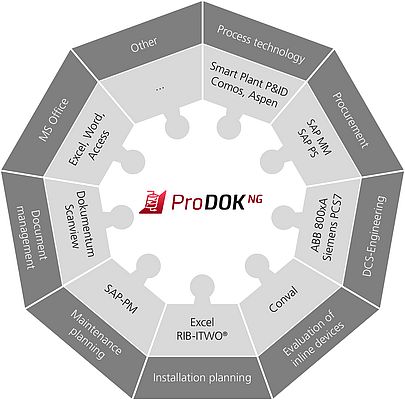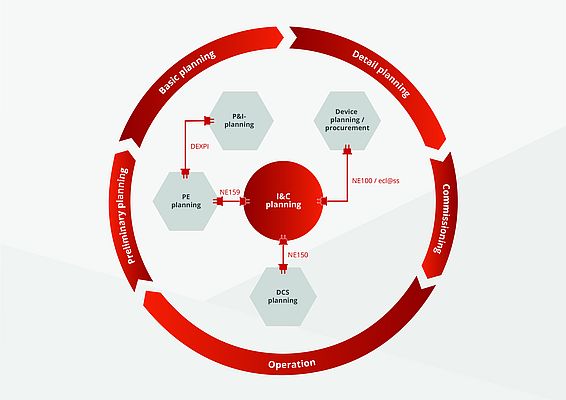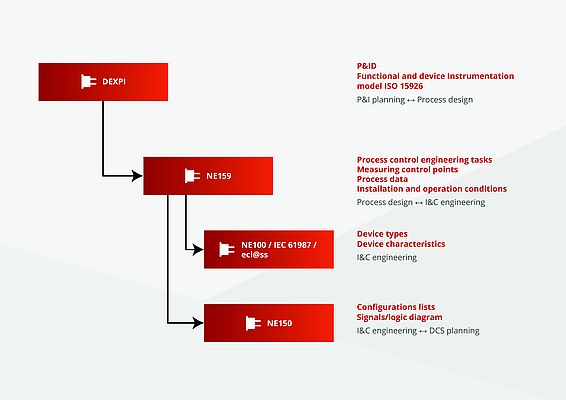The original founders of NAMUR (now the Automation Systems Interest Group of the Process Industry, previously “standardization association for measurement and control in chemical industries” – yielding the acronym “NAMUR” from the German title) already recognized the standardization of interfaces as one of the international association’s important tasks. One concrete example from the early days is the 4-20 mA-Signal. In the age of Industry 4.0, however, a much broader view of interface standardization needs to be taken:
Plant planning – not a linear process, but a cycle
When a new plant or section of a plant is built, planning and realization become increasingly concrete along the chain of preliminary planning – basic planning – detail planning – commissioning (Fig. 1). Today, in order to shorten the time-to-market, these steps often occur not consecutively, one after the other, but in parallel, meaning that detail planning is already underway even before the basic planning is completed. Thus communication at the relevant interfaces becomes increasingly important. At the same time, preliminary planning, basic planning, detail planning and commissioning are not to be regarded as linear processes that will be complete at some time.
As long as a plant in the process industry is in operation, it will continue to be constantly developed, either to enhance product quality, to make processes more efficient or to keep up with the technological state-of-the-art. Thus the process continually repeats itself, from preliminary planning to commissioning. Standardization is essential in order to avoid “friction losses” in the exchange of information at the interfaces between the areas of piping and instrumentation (P&I) planning, process engineering (PE) planning, instrumentation and control (I&C) planning and distributed control system (DCS) planning. Thus the theme of standardization is possibly even more important today than it was at the time when NAMUR was founded (Fig. 2).
Three important NAMUR recommendations for plant planning
Today, three NAMUR recommendations (NE) basically create the preconditions for plant owners to remain independent of specific manufacturers throughout the complete plant planning process when selecting the development tool that is ideally suited to each application, the most suitable component or the optimal control solution: NE159, NE100 (with IE61987 and eCl@ss), and NE150 (Fig. 3). These recommendations are complemented by DEXPI (Data Exchange in the Process Industry).
The first step in plant development is P&I planning. Piping and instrumentation are planned, and in the next step – namely process engineering planning – they are specified in more detail. Here DEXPI, as a standardized interface, is intended to avoid potentially error-prone data exchange. NE159, which is currently still in development, is mainly effective at the interface between PE (process engineering) planning and I&C planning. The aim of this recommendation is to formulate the requirements for a practicable, manufacturer-independent and semi-automatic interface for bidirectional data exchange between the engineering systems for PE planning and I&C planning.
NE100 is an international standard for the description of I&C devices (sensors, actuators, etc.) based on characteristics. It describes the two-way, automated transfer of data between the plant developer’s system and the system of the supplier. It is used at the interface between detail planning and commissioning – i.e. concretely in the planning and procurement of devices. It enables a better technical comparison of individual components at the offer stage. Optimization of data integration, from planning to procurement right through to maintenance, in order to achieve greater efficiency, is another of the many arguments in favor of applying NE100 in practice. Here, too, of course, standardization leads to improved data quality in addition to its other advantages.
Lastly, NE150 is a standardized interface for the exchange of engineering data between CAE system and DCS engineering tools. The diagram in Fig. 2 is a graphic representation of the planning and engineering process and the interfaces between the individual areas of engineering.
I&C planning, the pivotal aspect
If we consider the diagram more closely, it soon becomes apparent that I&C planning is the central aspect of the whole process. Thus it should not come as a surprise that the I&C-CAE system ProDOK (see Text Box 1) by Rösberg, the automation experts from Karlsruhe, implements all the NAMUR recommendations described above. However, it is in fact the only system available on the market at present which does so, and is unique in this respect. Ralph Rösberg, Managing Partner of Rösberg Engineering GmbH, explains the philosophy behind the system: “If a high-wage country like Germany wants to stay competitive in the international market, efficiency and high quality are important. In our view, both can only be achieved by standardization, and by an I&C-CAE system that puts these standards into practice. From the wide offer available on the market, users can then select the best of everything for their plant, whether it is engineering tools that are concerned, or components to be built into the plant.”
For this reason the automation experts take part in various standardization committees. They are actively represented in four working groups within NAMUR alone, as well as cooperating on DKE K941 (Cause & Effect Diagram) and VDI/GMA FA6.16 (Integrated engineering in I&C technology) (Fig. 4).
Users have a part to play
In industrial applications, the advantages of standardization emerge clearly, for instance, in relation to a current trend in the sector: to achieve a faster time-to-market, not only are process steps which used to be consecutive now being dealt with in parallel; there is also an increasing tendency to adopt a modularization approach. The idea behind this is to purchase whole plant modules, rather than develop them oneself. However in this situation, too, good documentation – and above all continuous and consistent documentation – of all parts of the plant is essential. Only in this way can the various elements function smoothly together without the need, for instance, to re-develop the connections and the operating and monitoring protocols for every bought-in module. But in order for good, practical NAMUR recommendations to be actually applied in reality, users also have to play their part.
Author: Dipl.-Ing. (BA) Martin Dubovy, Head of Plant Solutions Product Management, Rösberg Engineering GmbH




















